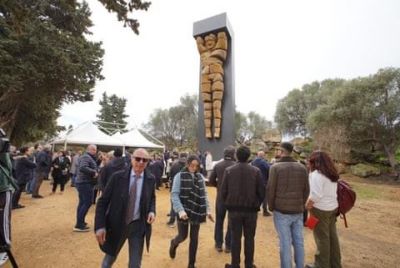A colossal statue of Atlas that lay buried for centuries among ancient ruins has been reconstructed to take its rightful place among the Greek temples of Agrigento in Sicily, after a 20-year research and restoration project. The statue, standing at 26 feet tall and dating back to the fifth century BC, was one of nearly 38 that adorned the Temple of Zeus, considered the largest Doric temple ever built despite never being completed. “The Atlas will become one of the highlights of the Valley of the Temples,” said Francesco Paolo Scarpinato, a cultural heritage assessor, in a joint statement with the Sicilian governor, Renato Schifani. “We can finally introduce this imposing work to the international community.” The statues were discovered in 1812 by Charles R. Cockerell, a young British architect who was visiting Agrigento to study the ruins of the ancient city of Akragas, founded in about 582 BC. Cockerell was one of the first people to realize that a massive piece of sandstone near the old Temple of Zeus was not a part of the sanctuary’s pediment but instead the head of a statue of Atlas. Cockerell later identified other pieces of the statues. According to archaeologists, the Atlases were located on the outer part of the Temple of Zeus, frozen in the act of supporting the temple and helping to sustain the entire entablature of the sanctuary, which was never completed because it was still lacking a roof when Akragas was conquered by the Carthaginians.
Una statua grandissima di Atlante sepolta da secoli è stata trovata in uno scavo per la prima volta. La statua è stata messa in un tempio greco ad Agrigento in Sicilia dopo una restaurazione durata vent’anni. La statua è alta quasi 8 metri e fu scolpita nel quinto secolo a.C. La statua in antichità faceva parte di una serie di 38 statute nel tempio dedicato a Zeus. La costruzione di questo tempio non fu mai completa. La statua, allora, rimase sepolta per secoli. Secondo Francesco Paolo Scarpinato, un esparto nella storia e cultura antica, L'Atlante diventerà uno dei pezzi forti della Valle dei Templi. Il governatore della Sicilia, Renato Schifani, ha dichiarato con molta felicità che l’Atlante può essere finalmente introdotta alla comunità internazionale. La statua fu scoperta nel 1812 da Charles R. Cockerell, un architetto inglese che ha viaggiato ad Agrigento per studiare le rovine della città antica Akragas, fondata nel 582 a.C. Cockerell è stato uno dei primi a scoprire un massiccio pezzo di arenaria sepolto sottoterra vicino il Tempio di Zeus. Si rese conto subito che si trattasse della testa di una statua di Atlante. Secondo gli archeologi, le 38 statue non furono mai state messe nel tempio perché il tempio non fu mai finito, ed in quanto la città di Akragas fu presto conquistata dai Cartaginesi.



